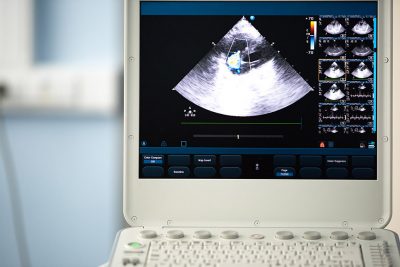
Favorable One-Year Results Reported from the LuX TTVR Device
June 1, 2025
By Jeffrey Zimmet, MD, PhD
Synopsis: One-year results from the TRAVEL study of the LuX transcatheter tricuspid valve replacement (TTVR) device demonstrates sustained reduction of tricuspid regurgitation to mild or less in more than 95% of patients, with improved functional status and reverse remodeling of the right ventricle.
Source: Pan X, Lu F, Wang Y, et al. Transcatheter tricuspid valve replacement with the novel system: 1-year outcomes from the TRAVEL study. JACC Cardiovasc Interv. 2025; Apr 2. doi: 10.1016/j.jcin.2024.12.030. [Online ahead of print].
Although surgical intervention remains the textbook recommendation for interventional treatment of tricuspid regurgitation (TR), it often is associated with poor outcomes and high procedural risk, with surgical mortality rates approaching 10% in many series. The landscape of transcatheter tricuspid valve interventions has expanded significantly over the past several years, with development and U.S. Food and Drug Administration (FDA) approval of devices for both transcatheter edge-to-edge repair (TEER) and for transcatheter tricuspid valve replacement (TTVR). A single TTVR device currently is approved in the United States, with multiple designs in advanced stages of clinical testing.
The current article presents findings from the TRAVEL study, a prospective, multicenter clinical trial conducted in China that evaluated the safety and effectiveness of the LuX-Valve, a novel TTVR device, in patients with severe or greater TR who were considered high risk for open-heart surgery.
The TRAVEL study enrolled 126 patients, all of whom were in New York Heart Association (NYHA) functional class III or IV and were deemed unsuitable for surgery. The average age of the participants was approximately 66 years and nearly 80% were women. The population had a high burden of comorbidities, with more than two-thirds having undergone previous left-sided valve surgery and nearly three-quarters having a history of atrial fibrillation. Additionally, almost half of the patients had been hospitalized for heart failure in the year preceding the study.
The LuX-Valve achieved procedural success in 97.6% of patients, with a mean device implantation time of only 15 minutes. There were no intraprocedural deaths. A single patient required open surgical rescue as the result of right ventricle perforation. A relatively small percentage of patients (1.6%) required new permanent pacemaker implantation, which compares favorably to the Evoque TTVR system that has reported rates as high as 11%.
At one-year follow-up, all-cause mortality was 10.3%, and the rate of heart failure-related hospitalization was 4.0%. This was a single-arm study without a medical therapy control arm. These results are compared with historical data, in which one-year mortality rates exceeding 40% are reported in similar high-risk TR populations. At baseline, every patient was classified as NYHA class III or IV, but by one year, only about 20% remained in these more symptomatic categories. There also was a significant improvement in six-minute walk time, with patients walking an average of 71 meters farther compared to baseline.
At one year, 95.2% of patients had TR graded as mild or less, and more than three-quarters of patients had trace or no regurgitation. Evidence of right heart reverse remodeling was reported, including reductions in right ventricular end-diastolic diameter, right atrial volume, and inferior vena cava diameter. Pulmonary artery systolic pressure also declined. Improvements in right ventricular systolic function were minimal, however.
The authors reported a high success rate with the LuX TTVR system, with sustained reduction in TR at one year and favorable remodeling of the right ventricle. They also posited a potential mortality benefit compared with historical controls.
Commentary
The LuX-Valve represents a promising therapeutic advancement for a patient group with limited treatment alternatives. This trial used the first-generation device that required transapical access; the second-generation device using trans-jugular deployment currently is in clinical trials. Safety of the procedure generally was high, and there were no cases of valve embolization.
Compared with the Evoque valve that was approved by the FDA in February 2024, the LuX-Valve has a different leaflet grasping system and relies less on radial force for stability, which may partly explain the significantly lower pacemaker rate. However, it should be noted that TRAVEL patients were younger (66 years vs. 79 years in TRISCEND I) with less atrial fibrillation at baseline. The passive leaflet grasping system also has the potential to lead to late paravalvular TR, and, indeed, a trend toward recurrent TR was noted here.
Significantly, the LuX-Valve system is able to treat larger tricuspid annuli, potentially expanding the availability of this procedure to more subjects. However, patients with severe right ventricular dysfunction or severe precapillary pulmonary hypertension are not suitable candidates for these devices. A similar percentage of evaluated patients were excluded compared with prior trials — 21 patients because of clinical characteristics and 29 patients because of anatomical limitations.
Although results from the TRAVEL study are encouraging, they must be interpreted in light of known limitations. The study was single-arm and non-randomized, lacking a blinded echocardiographic core lab and structured quality-of-life assessments. Further validation through randomized controlled trials will be essential for demonstrating any clear effects on hospitalization and mortality. As this field expands, selection of the most appropriate patients and devices for tricuspid intervention will continue to evolve.
Jeffrey Zimmet, MD, PhD, is Associate Professor of Medicine, University of California, San Francisco; Director, Cardiac Catheterization Laboratory, San Francisco VA Medical Center.